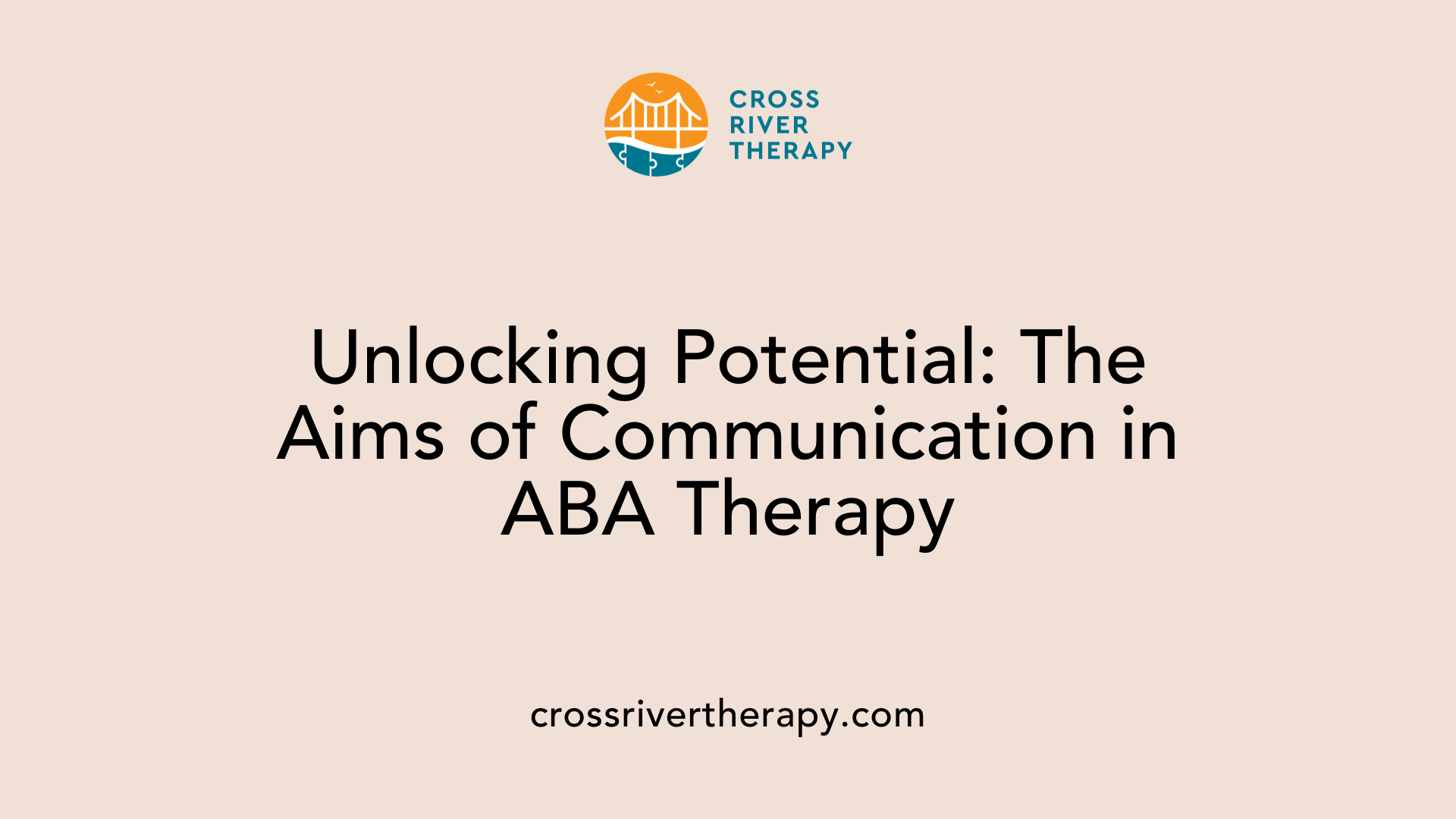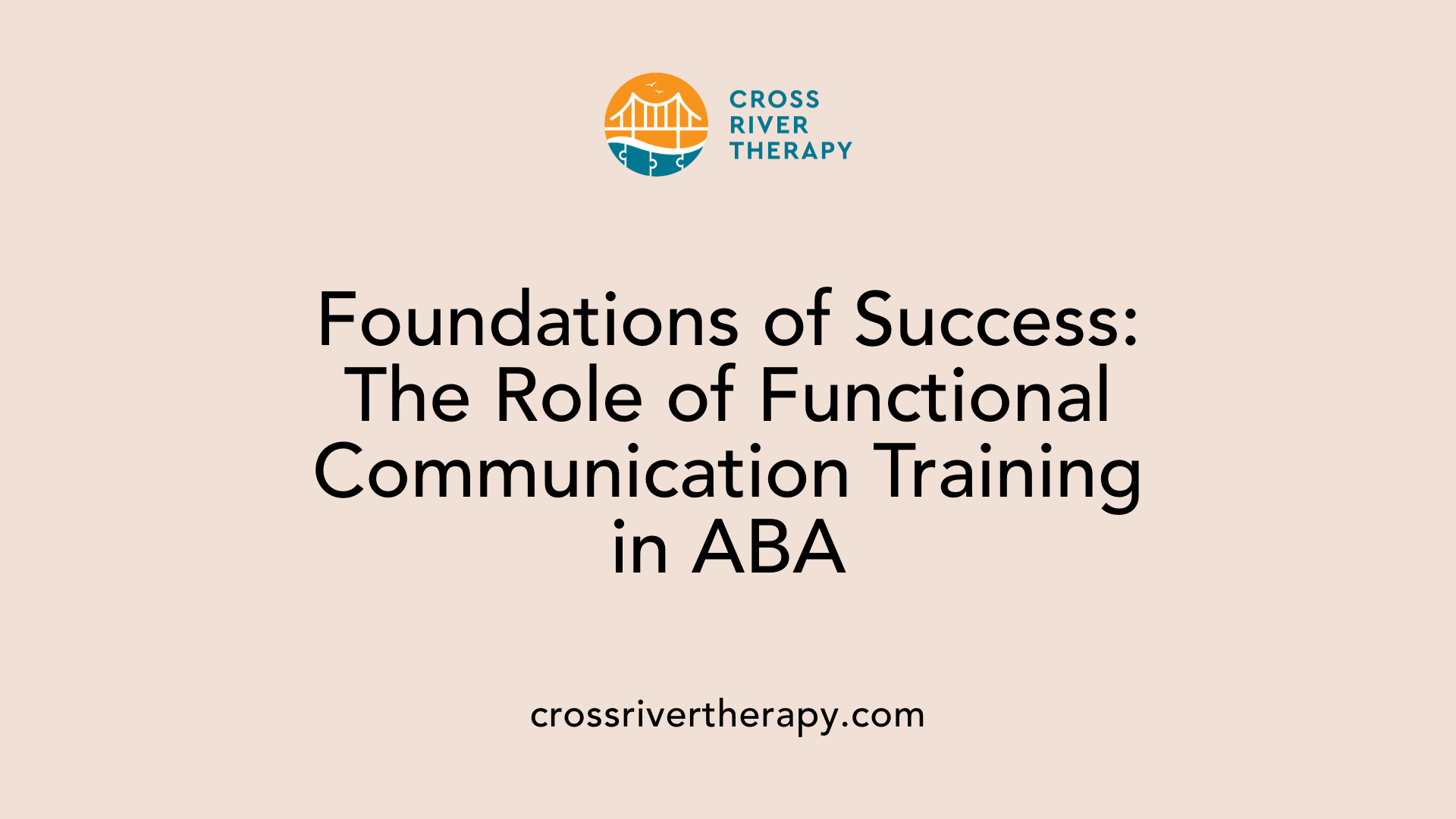Why Communication is Key in ABA Therapy for Children with Autism
Unraveling the Critical Role of Communication in ABA Therapy for Autism
The Foundation of Communication in ABA Therapy
Communication is the cornerstone of Applied Behavior Analysis (ABA) therapy, especially for children with autism, who often experience significant communication challenges. This therapy focuses on enhancing language and social skills to not only help children express their needs but also to foster meaningful relationships. Understanding the depth of communication's role in ABA therapy can illuminate the path toward more effective interventions and improved quality of life for children with autism.
The Goals of Communication in ABA Therapy

What are the goals of communication in ABA therapy?
The primary focus of communication in ABA therapy is to enhance language skills, which are vital for children with autism who face communication deficits. By addressing these challenges, ABA therapy aims to teach children how to:
- Request desired items: Learning to ask for what they want helps express needs more effectively.
- Understand and follow instructions: This skill fosters independence and helps children engage in everyday activities.
- Engage in social communication: Interacting with peers enhances social skills and emotional development.
- Use alternative communication methods: For those who are nonverbal, approaches like sign language or communication devices are integrated into therapy.
Research indicates that improved communication skills can reduce challenging behaviors, such as tantrums, by enabling children to express their needs and feelings more clearly. When children can communicate effectively, they are less likely to resort to frustrating behaviors.
As language skills bloom, additional benefits often emerge, including enhanced social interactions, improved academic performance, and stronger family bonds. The success of these therapeutic goals is significantly influenced by the intensity and duration of the ABA interventions, making early and sustained therapy essential for optimal outcomes.
The Crucial Nature of Communication Development for Children with Autism

Challenges in communication for children with autism
Children with Autism Spectrum Disorder (ASD) often face significant communication challenges. These can include
- Delayed speech,
- Difficulty in social communication,
- Echolalia (repeating others' words),
- Issues with non-verbal communication, and
- Limited joint attention.
Such deficits can severely hinder their ability to express needs and participate in social interactions, leading to frustration and behavioral issues.
Importance of effective communication
Effective communication is vital for children with autism, as it lays the foundation for building relationships and facilitating social interactions. Improving communication skills allows these children to:
- Express their needs more clearly,
- Reduce challenging behaviors,
- Enhance social skills,
- Increase their independence,
- Foster stronger family bonds.
Through targeted interventions like Applied Behavior Analysis (ABA), children are taught functional communication, which empowers them to engage meaningfully with their environment and peers. Notably, as children develop these skills, they not only gain confidence but also improve their overall quality of life.
The Benefits of Improved Communication in Therapeutic Settings

How do communication improvements benefit children with autism in therapy settings?
Improving communication skills is critical for children with autism in therapeutic settings. Enhanced communication abilities allow these children to express their needs and emotions more effectively, which is vital for reducing frustration and challenging behaviors often linked to difficulty in communication. When children can articulate their feelings and desires, the frequency of tantrums and other behavioral issues decreases significantly.
Reduction of challenging behaviors
With improved language skills, children gain a powerful tool to navigate their environment. As they learn to request items or express feelings, they become less reliant on problem behaviors to communicate. Positive reinforcement techniques used in ABA therapy not only reward effective communication but also redirect negative behaviors toward more functional methods of expression. This reduction in challenging behaviors fosters a more harmonious therapeutic environment and contributes to the overall emotional well-being of the child.
Improvement in social skills and relationships
The benefits of enhanced communication extend into social skill development. Children with autism learn to engage with peers, understand social cues, and build relationships through consistent practice in therapy. Strategies such as role-playing and group exercises teach them how to initiate conversations, recognize body language, and share discussion turns.
Improved communication facilitates better social interactions, leading to stronger relationships with both peers and caregivers. As a result, children experience greater independence and increased self-esteem, allowing them to participate more fully in their communities with a sense of belonging and connection.
| Benefit | Description | Impact on Daily Life |
|---|---|---|
| Reduction of challenging behaviors | Children express needs, reducing frustration and outbursts | A more peaceful therapeutic and home environment |
| Improvement in social skills | Enhanced ability to interact, understand cues, and engage | Stronger relationships and independence |
| Improved emotional expression | Children can articulate feelings clearly | Better coping strategies and emotional regulation |
| Increased self-esteem | Mastery of communication leads to confidence | Greater participation in social and community activities |
Strategies to Overcome Communication Challenges in ABA

What strategies in ABA therapy address communication challenges?
ABA therapy employs a variety of strategies to tackle communication challenges faced by children with autism. Central to these strategies is the use of visual aids, which can include picture boards and technology-based applications. These tools help children understand and practice communication, making it easier for them to articulate their thoughts and needs.
Another essential approach is positive reinforcement, which encourages children to use verbal communication or gestures. Rewards such as verbal praise, tokens, or small privileges create motivation, thereby promoting effective expression and reducing reliance on challenging behaviors.
Techniques like Functional Communication Training (FCT) focus on teaching children to replace problematic behaviors with appropriate methods of communication. This enables children to express their needs directly, minimizing frustration and behavioral issues.
Social skills training is also integrated into therapy sessions, enabling children to decipher social cues, initiate interactions, and maintain conversations. Through role-playing and interactive activities, they learn nuances that aid in social engagement.
Individualized therapy plans, grounded in comprehensive assessments of communication abilities, ensure that interventions are tailored to each child's unique needs. This personalized approach maximizes the effectiveness of ABA therapy, fostering substantial communication improvements.
Functional Communication Training: A Pillar of ABA Therapy

What role does Functional Communication Training (FCT) play in ABA therapy?
Functional Communication Training (FCT) is essential within ABA therapy, especially for children with autism who exhibit severe behavior problems. Introduced in the mid-1980s by Carr and Durand, FCT helps individuals learn to replace challenging behaviors with functional communication skills.
By conducting a comprehensive functional assessment, therapists identify the underlying reasons for problematic behaviors, which may include frustration from communication difficulties. Next, they select clear and easily understood communication responses for the child to learn. This method is implemented across various settings and with different caregivers, promoting consistency in communication approaches.
FCT emphasizes behavior extinction; this means that undesirable behaviors are not reinforced, which encourages children to utilize their new communication skills. Research indicates that FCT is effective in reducing disruptive behaviors among individuals with developmental disabilities, while also enhancing their overall communication abilities.
What are the implementation and benefits of FCT?
Implementing FCT requires training for caregivers and professionals to ensure effective and consistent application of strategies. Key strategies include prompting and shaping to gradually develop and reinforce functional communication.
The pitfalls of challenging behaviors can significantly diminish with proper FCT, leading to several benefits:
- Improved Communication Skills: Children learn to express their needs and desires more effectively.
- Reduced Problem Behaviors: Challenges such as tantrums often decrease as children become more adept at communicating.
- Enhanced Relationship Building: Better communication fosters stronger connections with peers and caregivers.
- Increased Independence: As children become more confident in their communication abilities, they gain autonomy in their interactions.
FCT serves as a vital foundation in ABA therapy, equipping children with the skills they need to engage meaningfully with their world.
Beyond Communication: The Broader Impact of ABA Therapy
Overall developmental improvements through ABA
Applied Behavior Analysis (ABA) therapy extends far beyond enhancing communication skills for children with autism. One of the notable outcomes of effective ABA interventions is the significant improvement in overall developmental milestones. As children learn to express themselves more clearly, there is frequently a corresponding enhancement in their social interactions and academic performance. This holistic growth not only fosters greater independence but also boosts self-esteem, enabling children to participate more actively in their communities.
Collaborative efforts in therapy
Collaboration is pivotal in maximizing the benefits of ABA therapy. Therapists work closely with parents and caregivers to reinforce communication skills learned during sessions. This partnership ensures consistency in techniques applied, allowing for real-world practice in familiar settings. Moreover, integrating elements such as play therapy and group therapy offers children opportunities to practice newly acquired skills with peers, enhancing their social competence and ability to interpret social cues.
| Benefits of ABA Therapy | Description | Additional Insights |
|---|---|---|
| Improved communication skills | Children learn to express needs effectively | Reduces tantrums that stem from communication deficits |
| Enhanced social interactions | Facilitates engagement with peers | Promotes understanding of social cues and body language |
| Increased independence | Children gain life skills, such as self-advocacy | Encourages participation in community activities |
| Development of emotional regulation | Helps children manage their emotions and reactions | Supports long-term emotional well-being |
Conclusion: Empowering Communication for Lifelong Benefits
In conclusion, communication in ABA therapy extends beyond teaching basic language skills—it is about empowering children with autism to effectively interact with their environment and forge meaningful connections with others. By addressing communication barriers and leveraging tailored strategies such as Functional Communication Training, ABA therapy paves the way for enhanced social integration, emotional well-being, and independence. As children develop these crucial skills, they experience fewer behavioral challenges and a greater sense of belonging in their community, ultimately improving their overall quality of life. For parents and caregivers, understanding the pivotal role of communication in ABA therapy can help guide their support and advocacy for the best possible outcomes for their children.
References
- ABA Therapy for Improving Communication and Language Skills
- How ABA Therapy Can Improve Communication Skills in Children
- How Does ABA Therapy Help with Communication?
- Using ABA Therapy to Develop Communication Skills in Children ...
- How ABA Therapy Helps Improve Communication Skills in Kids
- ABA Communication Goals and Skills - Empower Behavioral Health
- Applied Behavior Analysis (ABA) | Autism Speaks
- Bridging the Gap: Functional Communication in ABA
- 5 Tangible Ways ABA Therapy Helps Children with Autism
- How ABA Therapy Improves Communication and Language Skills



